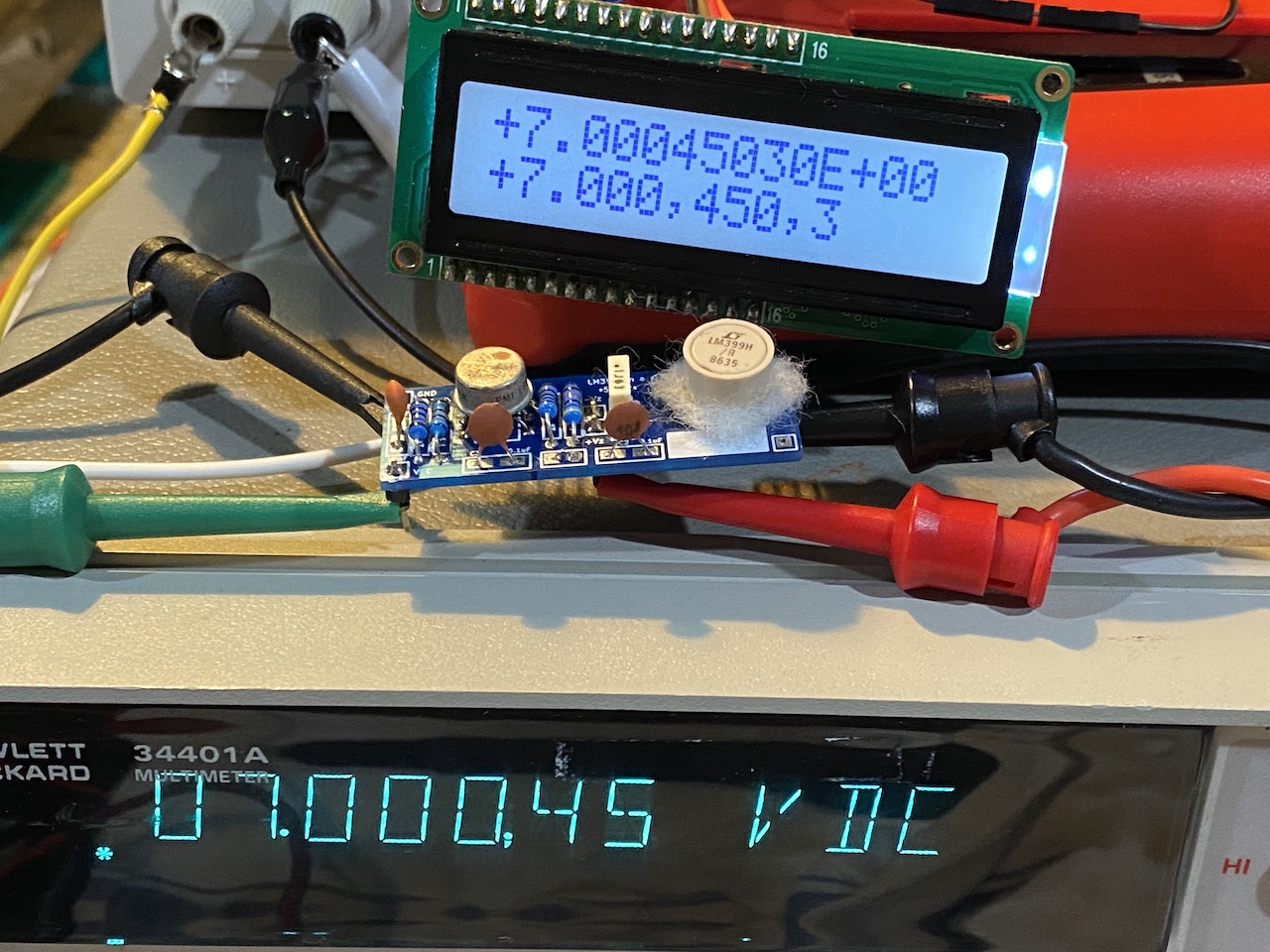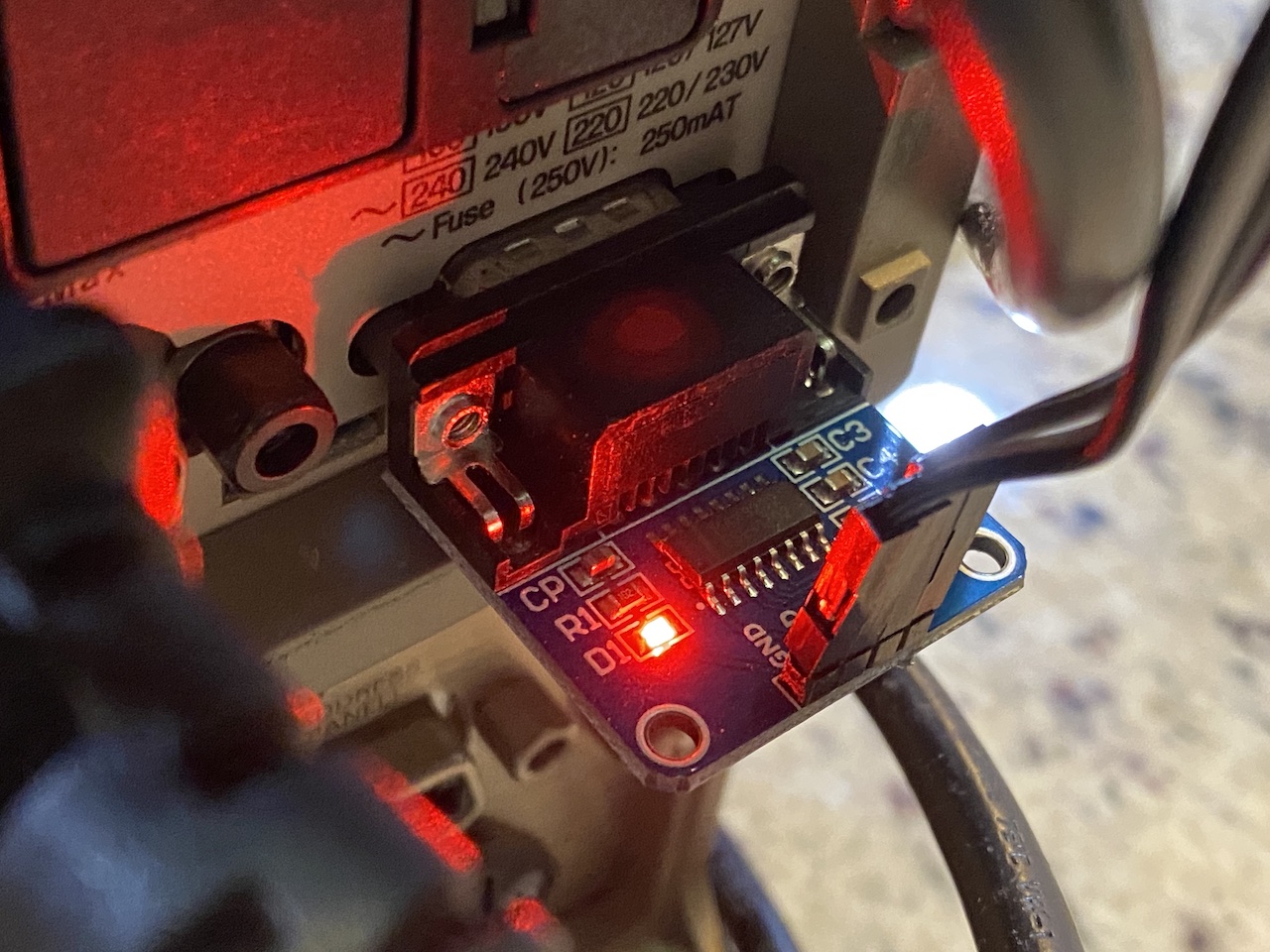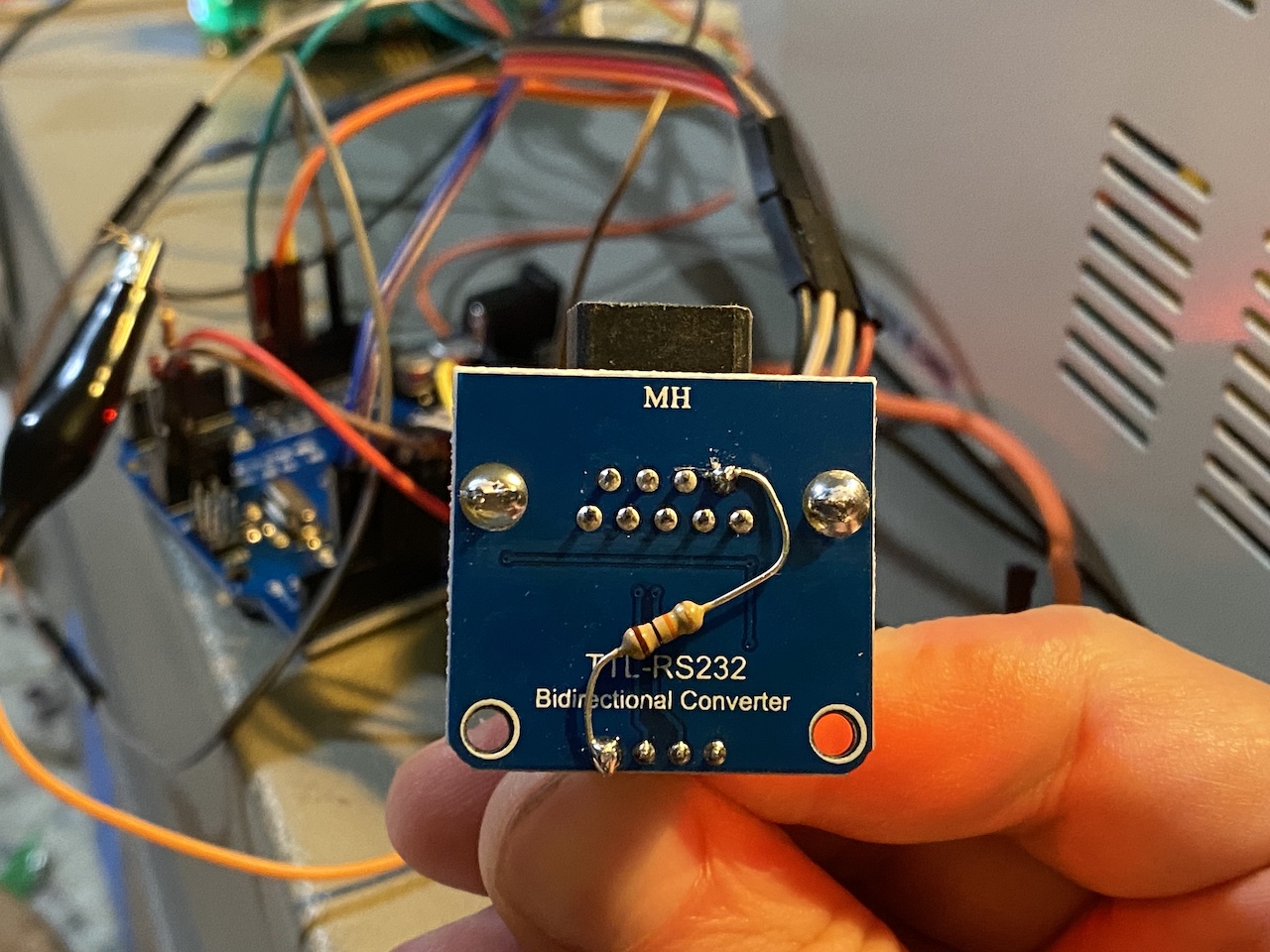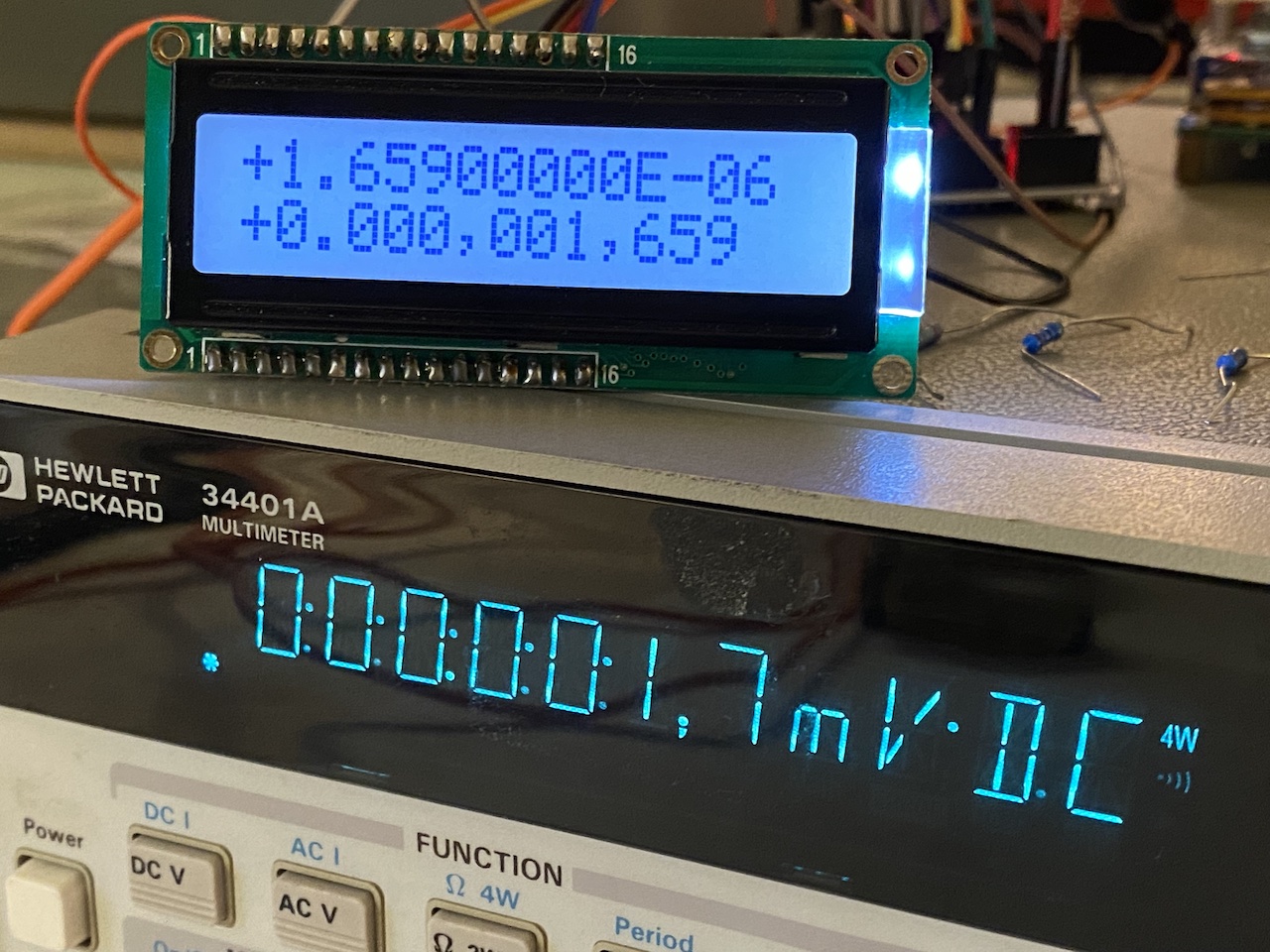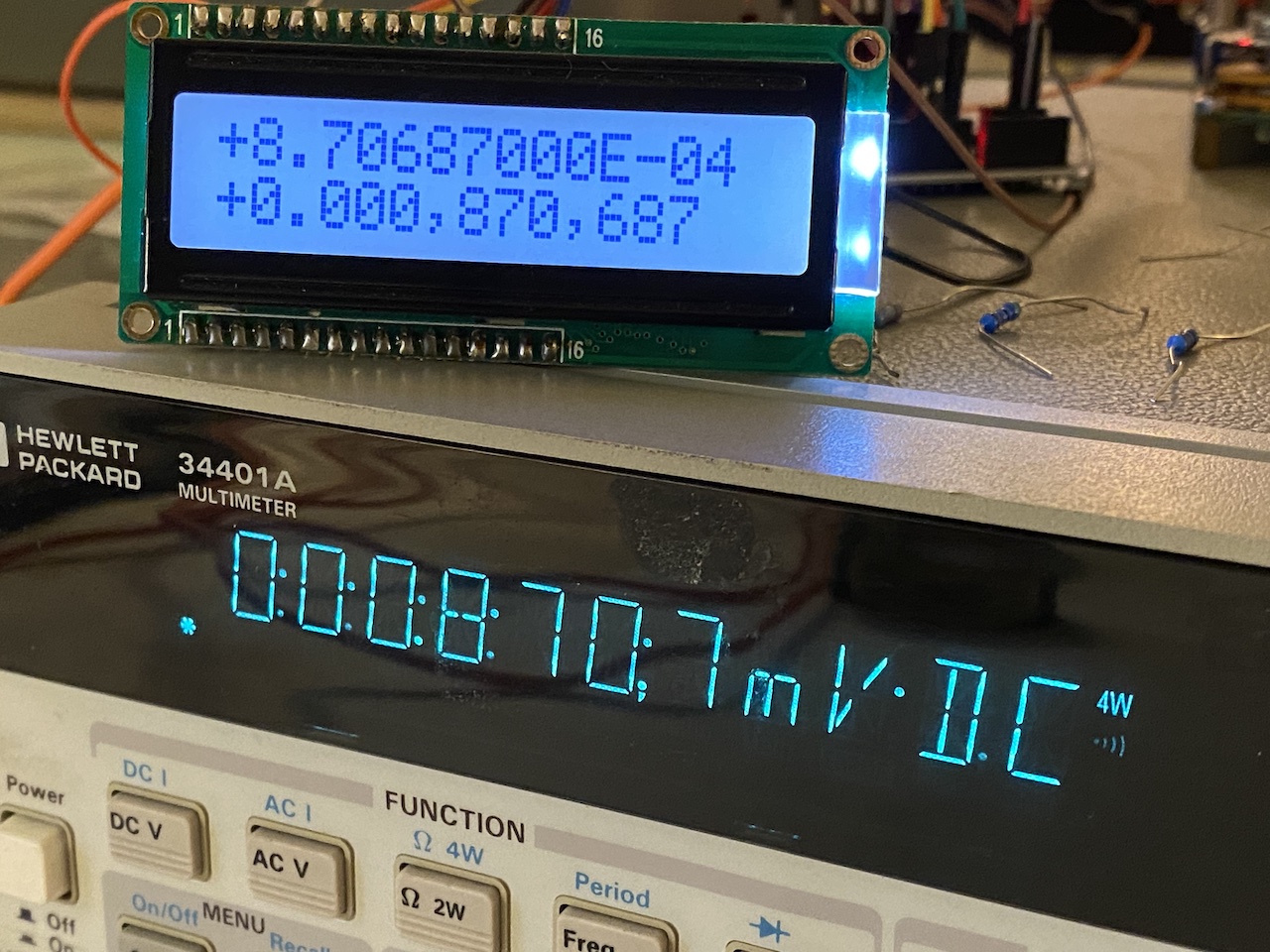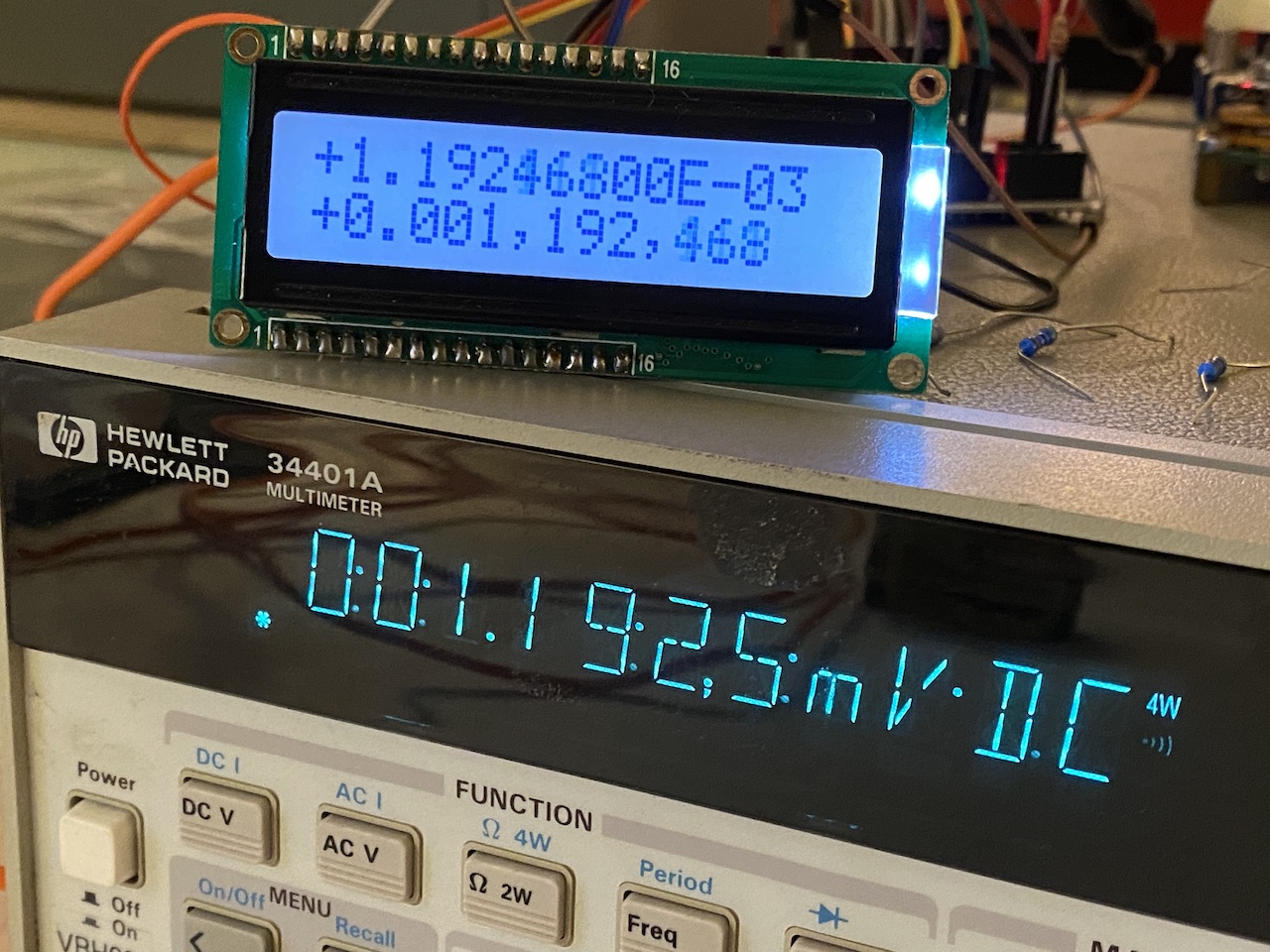|
// hp34401a-lcd.ino: Arduino sketch to display HP 34401A readings on a 16x2 LCD |
|
// as well as send them out the serial port. |
|
|
|
// Copyright 2022 Jason Pepas. |
|
// Released under the terms of the MIT License. |
|
// See https://opensource.org/licenses/MIT. |
|
|
|
// Setup: |
|
|
|
// First, set your 34401A to "talk only" mode: |
|
// Menu -> I/O Menu -> HP-IB Addr -> 31. |
|
|
|
// Next, prepare a RS232-to-TTL adapter by soldering a pull-up resistor from |
|
// the DB9 pin 6 (the DSR pin) to VCC (5V). |
|
// See https://gist.github.com/cellularmitosis/1582236f226e9d98075a0c971eb4168c for soldering details. |
|
|
|
// Thanks to: |
|
// https://www.eevblog.com/forum/testgear/external-display-for-agilent-34401a-(or-any-dmm-with-rs232-output-stream)/msg326470/#msg326470 |
|
// "Set DB9 pin 6 DSR high 5V" |
|
|
|
|
|
// Pins: |
|
|
|
#define LED_pin (13) // The onboard Arduino LED. |
|
|
|
// The RS232-to-TTL adapter will have four pins: |
|
// Pin 1: GND, connect to Arduino GND. |
|
// Pin 2: RX, connect to hp_rx_pin. |
|
// Pin 3: TX, connect to hp_tx_pin. |
|
// Pin 4: VCC, connect to Arduino 5V. |
|
#define hp_rx_pin (8) |
|
#define hp_tx_pin (9) |
|
|
|
// A standard 16x2 "1602" LCD module. |
|
// Pin 1: VSS, connect to Arduino GND. |
|
// Pin 2: VDD, connect to Arduino 5V. |
|
// Pin 3: VO (contrast): |
|
// Create a 0.6V reference by connecting Arduino 5V or 3.3V to a 10k resistor |
|
// to a diode to GND. Connect VO to the 0.6V point of the reference. |
|
// Pin 4: RS, connect to LCD_RS_pin. |
|
// Pin 5: RW, connect to Arduino GND. |
|
// Pin 6: E, connect to LCD_EN_pin. |
|
// Pin 11: D4, connect to LCD_D4_pin. |
|
// Pin 11: D5, connect to LCD_D5_pin. |
|
// Pin 11: D6, connect to LCD_D6_pin. |
|
// Pin 11: D7, connect to LCD_D7_pin. |
|
// Pin 12: A (backlight LED anode): |
|
// Some 1602 boards need a current limiting resistor and some don't. |
|
// Connect a 220R from Arduino 5V to the A pin. If it is very dim, try |
|
// omitting the resistor. |
|
// Pin 13: K (backlight LED cathode), connect to Arduino GND. |
|
#define LCD_RS_pin (3) |
|
#define LCD_EN_pin (2) |
|
#define LCD_D4_pin (4) |
|
#define LCD_D5_pin (5) |
|
#define LCD_D6_pin (6) |
|
#define LCD_D7_pin (7) |
|
|
|
|
|
#include <LiquidCrystal.h> |
|
LiquidCrystal lcd(LCD_RS_pin, LCD_EN_pin, LCD_D4_pin, LCD_D5_pin, LCD_D6_pin, LCD_D7_pin); |
|
|
|
#include <SoftwareSerial.h> |
|
SoftwareSerial hp_serial(hp_rx_pin, hp_tx_pin); |
|
|
|
|
|
void setup() { |
|
pinMode(LED_pin, OUTPUT); |
|
lcd.begin(16, 2); |
|
Serial.begin(9600); |
|
hp_serial.begin(9600); |
|
|
|
lcd.clear(); |
|
lcd.setCursor(0, 0); |
|
lcd.print("HP 34401A"); |
|
delay(1000); |
|
} |
|
|
|
|
|
// Data will stream from the 34401A in the following format: |
|
// -9.34000000E-07\r\n |
|
// +2.24900000E-06\r\n |
|
|
|
#define BUF_LEN (17) // e.g. '+2.24900000E-06\r\n' |
|
char buf[BUF_LEN+1]; |
|
|
|
void loop() { |
|
// Reset to read the next value. |
|
memset(buf, '\0', BUF_LEN+1); |
|
int chars_read = 0; |
|
|
|
while (true) { |
|
// Spin until there is a char available to read. |
|
if (hp_serial.available() == 0) { |
|
continue; |
|
} |
|
|
|
// Read one char. |
|
char ch = hp_serial.read(); |
|
|
|
// Handle the end of the line. |
|
if (ch == '\r' || ch == '\n') { |
|
// The line ending is '\r\n'. Throw away the '\n'. |
|
if (chars_read == 0) { |
|
break; |
|
} |
|
|
|
// Convert the line to a float. |
|
float f = atof(buf); |
|
|
|
// Determine the exponent value, e.g. 'E-02' == 2. |
|
int exponent = (buf[14] - '0') + (10 * (buf[13] - '0')); |
|
if (buf[12] == '-') { |
|
exponent = -exponent; |
|
} |
|
|
|
// Format the value in non-scientific notation. |
|
char formatted[12+1]; // e.g. '-123456789.1', '-0.000000001' |
|
int dot_index = -1; |
|
// -1.0E-3 = -0.001 |
|
// -1.0E-2 = -0.01 |
|
// -1.0E-1 = -0.1 |
|
// -1.0E0 = -1.0 |
|
// -1.0E1 = -10.0 |
|
// -1.0E2 = -100.0 |
|
// -1.0E3 = -1000.0 |
|
if (exponent < 1) { |
|
dot_index = 2; |
|
} else { |
|
dot_index = 2 + exponent; |
|
} |
|
formatted[0] = buf[0]; // the leading '+' or '-'. |
|
int in_index = 1; |
|
int out_index = 1; |
|
int trailing_zeros = 0; |
|
if (exponent < -1) { |
|
trailing_zeros = (-exponent) - 1; // e.g. if the exponent is -5, there will be 4 trailing zeros. |
|
} |
|
while (in_index < (11 /* the 'E' */ - trailing_zeros)) { |
|
if (in_index == 2 /* the '.' */) { |
|
in_index += 1; |
|
continue; |
|
} else if (out_index == dot_index) { |
|
formatted[out_index] = '.'; |
|
out_index += 1; |
|
continue; |
|
} else if (exponent < 0 && out_index < (-exponent)+2) { |
|
formatted[out_index] = '0'; // leading zero's, e.g. 0.001. |
|
out_index += 1; |
|
continue; |
|
} else { |
|
formatted[out_index] = buf[in_index]; |
|
in_index += 1; |
|
out_index += 1; |
|
continue; |
|
} |
|
} |
|
formatted[out_index] = '\0'; |
|
|
|
// Format the value in non-scientific notation, with commas and underscores. |
|
char formatted2[14+1]; // e.g. '-123,456,789.1', '-0.000_000_001' |
|
int comma1_index = -1; |
|
int comma2_index = -1; |
|
int under1_index = -1; |
|
int under2_index = -1; |
|
if (exponent >= 6) { // at or above 6 we have two commas and no unders. |
|
// -1.0E7 = -10,000,000.0 |
|
// -1.0E6 = -1,000,000.0 |
|
dot_index += 2; |
|
comma1_index = exponent - 4; |
|
comma2_index = exponent; |
|
} else if (exponent == 4 || exponent == 5) { // for 4 and 5 we have one comma and no unders. |
|
// -1.0E+6 = -1,234,567.8 |
|
// -1.0E+5 = -123,456.78 |
|
// -1.0E+4 = -12,345.678 |
|
// -1.0E+3 = -1,234.567_8 |
|
dot_index += 1; |
|
comma1_index = exponent - 1; |
|
} else if (exponent == 3) { // for 3 we have one comma and one under. |
|
// -1.0E+4 = -12,345.678 |
|
// -1.0E+3 = -1,234.567_8 |
|
// -1.0E+2 = -123.456_78 |
|
dot_index += 1; |
|
under1_index = 10; |
|
} else if (exponent == 1 || exponent == 2) { // for 2 and 1 we have no commas and one under. |
|
// -1.0E+3 = -1,234.567_8 |
|
// -1.0E+2 = -123.456_78 |
|
// -1.0E+1 = -12.345_678 |
|
// -1.0E+0 = -1.234_567_8 |
|
under1_index = exponent + 6; |
|
} else if (exponent <= 0) { // at or below zero, we no commas and two unders. |
|
// -1.0E+1 = -12.345_678 |
|
// -1.0E+0 = -1.234_567_8 |
|
// -1.0E-1 = -0.123_456_78 |
|
// -1.0E-2 = -0.012_345_678 |
|
// -1.0E-3 = -0.001 |
|
// -1.0E-4 = -0.000_1 |
|
// -1.0E-5 = -0.000_01 |
|
under1_index = 6; |
|
under2_index = 10; |
|
} |
|
formatted2[0] = buf[0]; // the leading '+' or '-'. |
|
in_index = 1; |
|
out_index = 1; |
|
int copied_digits = 0; |
|
while (in_index < (11 /* the 'E' */ - trailing_zeros)) { |
|
if (in_index == 2 /* the '.' */) { |
|
in_index += 1; |
|
continue; |
|
} else if (out_index == dot_index) { |
|
formatted2[out_index] = '.'; |
|
out_index += 1; |
|
continue; |
|
} else if (out_index == comma1_index || out_index == comma2_index) { |
|
formatted2[out_index] = ','; |
|
out_index += 1; |
|
continue; |
|
} else if (out_index == under1_index || out_index == under2_index) { |
|
formatted2[out_index] = ','; |
|
out_index += 1; |
|
continue; |
|
} else if (exponent < 0 && out_index < (-exponent)+2) { |
|
formatted2[out_index] = '0'; // leading zero's, e.g. 0.001. |
|
out_index += 1; |
|
continue; |
|
} else if (exponent <= -5 && out_index < (-exponent)+3) { |
|
formatted2[out_index] = '0'; // leading zero's, e.g. 0.001. |
|
out_index += 1; |
|
continue; |
|
} else { |
|
formatted2[out_index] = buf[in_index]; |
|
in_index += 1; |
|
out_index += 1; |
|
copied_digits += 1; |
|
if (copied_digits == 8) { |
|
break; |
|
} |
|
continue; |
|
} |
|
} |
|
formatted2[out_index] = '\0'; |
|
|
|
// Send the formatted value out the (hardware) serial port. |
|
Serial.print(formatted); |
|
Serial.print("\n"); |
|
digitalWrite(LED_pin, LOW); |
|
|
|
// Print the formatted value on the second line of the LCD. |
|
lcd.setCursor(0, 1); |
|
lcd.print(formatted2); |
|
break; |
|
} |
|
|
|
// Accumulate chars into the buffer and echo them to the LCD. |
|
digitalWrite(LED_pin, HIGH); |
|
buf[chars_read] = ch; |
|
if (chars_read == 0) { |
|
lcd.clear(); |
|
} |
|
lcd.setCursor(chars_read, 0); |
|
lcd.print(ch); |
|
chars_read += 1; |
|
continue; |
|
} |
|
} |
